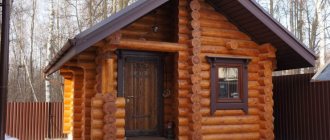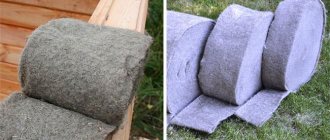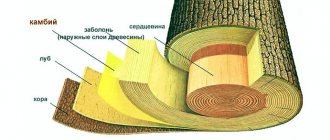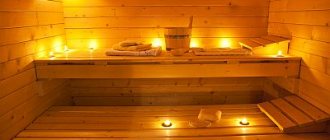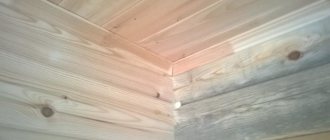How to cover the inside of a log house, and is it necessary to do it at all? Manufacturers of logs and timber often claim that wooden houses do not require interior finishing at all, but this is not entirely true.
Wood really looks very beautiful, and covering it with any materials is not the best solution, but it needs protection from various damaging factors, so it is impossible to do without treatment at all. Its purpose is not only a decorative, but also a protective coating, which, moreover, will preserve the natural texture of the wood.
What treatment is needed for a log house?
A brand new, newly built log house looks just great, and many owners are not going to use any additional coatings. But wood is a living material, subject to various physical and biological negative factors, so very soon it will begin to turn black, and then rotting processes will begin, which will significantly shorten the life of the house.
Because of this and some other reasons, it is imperative to take care of protecting walls and all wooden structural elements with the help of special coatings. What is the best way to treat a log house?
Preparatory work
After sanding, the wood absorbs protective compounds better.
Compounds should not be applied to old paintwork, dirt, tar or damaged timber. Before treating a wooden house outside and inside, the surface is prepared. Old paint or varnish is heated until softened and removed with a scraper. Then the log house is polished with a special machine. The procedure allows you to remove unevenness and defects, dark spots, and improves the appearance of the material. Removing the top layer opens the wood pores, allowing deep penetration of the impregnation. Grinding occurs with coarse and fine abrasives. After the procedure, the surface and surrounding objects are cleaned with a vacuum cleaner.
What should you protect a wooden house from?
Processing of a log house is required for several reasons. Wood is threatened not only by microorganisms, but also by other factors, each of which requires specialized protection. How to treat a log house inside a house?
- Wood needs protection from insects: wood-boring beetles infect all wooden elements, which ultimately leads to a decrease in strength and premature collapse. In addition, wooden structures can be damaged by rodents. House logs and other parts are treated with an antiseptic against all biological threats: this is a special composition that prevents rotting.
- Wood is a flammable material, and this threat cannot be ignored. A faulty heating system or faulty electrical wiring can lead to a fire that ultimately completely destroys the house. To prevent disaster, the building must be carefully treated with fire retardants. These are substances that prevent combustion. With their help you can protect walls and prevent the spread of fire.
- Wood, especially pine, is prone to discoloration, which indicates the beginning of the destruction of the top layer. To protect against putrefactive processes and the negative effects of moisture, the log house can be painted, for which all kinds of water-based varnishes and paints are used. If you do not want to hide the natural texture of the wood, you can use glaze compounds, which, thanks to their translucent composition, will allow you to demonstrate the beauty of the wood.
When choosing how to treat a log house, you need to pay attention to the quality of the purchased building materials. The durability of the entire structure and its security will depend on the reliability of processing, so it is better not to save money here. Russian and Finnish antiseptics and fire retardants are in great demand today; they can be purchased at any hardware store.
How and when to treat at home
The initial treatment of wood with antiseptics is carried out by the manufacturer of the log or timber, as it should protect the material from rotting during storage and delivery to the site. After construction, the log house must be left for six months until the final completion of shrinkage.
How to treat a log house? There are two options:
- Manual. Antiseptics, fire retardants and paints are applied manually using brushes and rollers of various sizes. The advantages are clear: you can process and then paint literally every centimeter of the space, but such work requires a lot of time. You will have to spend more than one day, in addition, it is advisable to have the skill of painting a log, since the paint may lie unevenly.
- Using a spray bottle. A sprayer will speed up processing many times over, but you need to know how to work with it. In any case, the sprayer will not help in processing the joints of logs; difficult areas will still have to be passed over with a brush several times.
The lower crown of the bath
The lower crown of the log house is most susceptible to rotting
The lower crown of the bathhouse is most susceptible to moisture. Therefore, it often rots very quickly. The entire frame is still in excellent condition, but it has to be replaced. What to do?
First, let's determine why the lower crown of the bathhouse rots very quickly. The causes of rotting must be determined in order to take a number of protective measures even when assembling a new log house.
The healthy condition of the lower crown is influenced by the following constructive measures when building a wooden house or bathhouse, which must be done without errors:
- a waterproofing layer of roofing felt on the surface of the concrete foundation in front of the brickwork of the base. This layer of waterproofing prevents moisture from rising from below and absorbing it into the brick material. Wet brick is not the best basis for the lower log of a log house.
- the second waterproofing layer of roofing felt is placed on the upper level of the brickwork of the base. It is the roofing felt that comes into contact with the wood of the lower crown of the log house. This contact must be made correctly.
- vents in a brick base or concrete foundation in order to provide natural ventilation in the underground.
- to prevent rainwater from getting in and stagnating on the roofing felt (see point 2), it is necessary to make a protective flashing. Its design can be different depending on the chosen material. You can simply cover the joint with a flashing board around the perimeter of the log house. You can make a drain from galvanized steel or buy it ready-made and install it so that it covers the joint and, at the same time, protects the basement part of the bathhouse from rain due to a slight offset from the outer edge of the brickwork. You can make a screed with a slope from cement-sand mortar along the upper edge of the base and stick soft tiles along it.
- Treat the lower rims with protective compounds in several layers
The absence of any of the above measures leads to rapid rotting of the casing.
The best way to avoid replacing the lower crowns is to make them from larch. Larch has the ability to harden (turn to stone) even more in the presence of moisture. It is not susceptible to fungi.
If it is not possible to get larch logs and in your region only pine is used for log houses, then you can compromise and find at least a larch board. By placing it under the lower crown, you can solve the problem of replacing the lower crowns in the same way if there were a pair of lower logs made of larch. The option is quite generous in monetary terms.
If you can’t get larch boards, then oak grows everywhere. Oak boards are a good alternative to deciduous boards. In addition, it is easier to replace the board than the lower crown.
Regarding the second point of protective measures: since the waterproofing from the roofing felt layer has a horizontal surface on which the lower log is laid, it is natural that water can stand here in puddles. Therefore, it is necessary to ensure that the surface of the roofing material is not horizontal, but has a slight slope to the outer sides to allow water to flow to the ground.
It's very easy to do:
- cut narrow strips of roofing felt approximately 5 cm wide
- put them 3-4 pieces together
- lay these roofing felt strips in the middle of the width of the plinth (or foundation)
- on top of them, place a layer of roofing felt slightly wider than the width of the plinth. (Usually a meter-wide roll of roofing felt is cut in half, resulting in a width of 500 mm, which is quite enough for waterproofing along the plinth (or foundation).
These additional soft “pads” will give you the following benefits:
- a soft “lining” will close the gaps that have formed between the log and the surface of the plinth due to unevenness of the lower surface of the log itself. In a normal situation, they are either left uncovered and the floor is raised above this joint so that it ends up underground. Or they are plugged with tow, but always from the outside; the joint is sealed with some kind of elastic sealant to prevent the tow from getting wet. This option is not entirely reliable. Better tightness is achieved through a soft “gasket”
- since in the middle it will be higher due to 5 layers of roofing material (4 narrow strips and 1 layer of a wide main strip), then the surface of the waterproofing layer will have a slope for water to drain from its surface.
Even with this design of roofing felt waterproofing, it is necessary to cover the lower crown and the upper part of the base with a galvanized or painted steel drain to prevent any moisture from getting under the lower log (see paragraph 4 of protective measures).
Important subtleties of home processing
Antiseptic treatment is the most critical stage, as it requires deep impregnation and maximum attention to quality. The composition is applied in several layers, and the treatment is carried out horizontally: first, one log is completely covered with an antiseptic, then the next.
Particular attention should be paid to the first crown, which suffers most seriously from exposure to moisture, and to the ends of the logs. Significantly more protective compounds are always used on the ends; this should be taken into account when purchasing.
Only after the first layer of antiseptic has dried can re-treatment be carried out. This procedure may take two days, but the house will receive the most reliable and durable protection.
The question often arises: will chemical treatment be harmful to the log house? Since it protects it from rotting, this outweighs the possible harm caused by the use of chemical compounds.
Source
Why do you need to process?
A log house is a choice in favor of environmental friendliness, taking care of your health and your loved ones. Treatment of the walls of wooden houses is necessary not only as protection, but also to extend the service life of the material and stability .
When it comes to the reliability of construction materials, each material, including logs and other types of wood, is considered based on all possible factors affecting it.
These are the following factors:
These and other factors force owners of wooden houses to take protective measures before such problems arise. To summarize on all points, the processing provides the following:
- Protection of logs from destruction.
- It is also important for the log to maintain its fresh appearance for as long as possible. This effect can only be achieved through timely processing.
- The treatment prevents the attack of fungi and other wood rot.
- Protects against moisture.
- Protects against insects.
- Extends the service life of the building.
- Improves the aesthetic characteristics of the building.
- Increases resistance to fire.
Top best products for external wood treatment
| Brand | Characteristic | Price |
| Senezh (Russia) | High-class, difficult-to-wash compounds in 20 types, including whitening and renewing compounds, antiseptics for baths, homes and gazebos; protect from fire, pests and moisture, provides protection for more than 10 years! | from 380 rubles (5kg) |
| Belinka (Slovenia) | Natural and safe, highly effective products that protect against ultraviolet radiation, moisture, insects and fire, a wide range of products | from 400 rubles (1l) |
| Pinotex (Estonia) | Polymer-based products protect against mold and moisture, fungus and insects, and withstand sudden temperature changes, therefore they are optimal for external treatment | from 280 rubles (1 l) |
| Neomid (Russia) | Effective impregnation for home, bathhouses and wooden floors, protects the surface from moisture for 5-7 years, they produce special products for treating the ends, a good price-quality ratio | from 200 rubles (1 l) |
| Tikkurila (Finland) | Moisture-resistant products, create a thin protective film and provide reliable protection from precipitation, are distinguished by high quality and positive reviews | from 250 rubles (1l) |
| Aquatex (Russia) | Available in the form of a primer and impregnation, colorless and tinted versions (15 colors), protects against fungus, ultraviolet radiation and moisture, suitable for middle-class wood | from 200 rubles (1 l) |
| Sitex (Russia) | Suitable for any type of wood, protects logs from moisture, preserves the appearance of the structure for 10 years, colorless and tinted options (12 colors) | from 200 rubles (1 l) |
Types of materials
Materials for protecting logs are divided into the following types according to functionality:
- Whitening.
- Fire retardant.
- Antiseptic.
Let's look at each of the options in more detail.
Bleaching agents
The most popular means for bleaching logs are as follows:
- Holzentgrauer is a universal water-based impregnation. The manufacturer is the well-known DUFA brand, distinguished by excellent product quality. The brand offers a wide range of colors for the treatment fluid. Holzentgrauer not only protects the wood, but also helps restore the original physical properties of the material.
By applying this product, you can forget about such problems as black or blue logs, cracks, dampness, fungi, mold, insect larvae or fire. The product is very easy to work with. It belongs to the safe types of chemical compounds. Price – about 200 rubles. for 1 kg.
SAGUS .
It is used for a wide range of sawn and planed materials, and is also capable of protecting even concrete, tiles, stone or brick. The product is suitable for both external and internal use.
The drug actively protects the log from fungal infections and darkening of the surface. It also removes existing larvae of harmful biological microorganisms.
When working with SAGUS, it is necessary to monitor the ambient temperature - it should be at least +5 degrees. Before applying the composition, the surface of the wood should be sanded properly, the log houses should be dried and cleaned of dust.
Repeated application is permissible no earlier than 40 minutes. Complete drying will take about 24 hours if the humidity does not exceed 60%. From a technical point of view, SAGUS is a low-hazard composition for humans. Average price – 800 rub. for 10 l. NEOMID 500 is a popular whitening and cleansing composition. It is effective against the larvae of destructive fungi. If the log already has the first signs of damage, then NEOMID 500 stops this process and restores the original properties of the wood. It is often used to process pallets on which food products are transported and stored.
When working with NEOMID 500, it is important to ensure that the product does not get on the galvanized fasteners of the structure. It is permissible to use a glass or plastic container to dose the product. The product is applied diluted with water in a ratio of 1:1 - for the protective layer and 1:2 - in the presence of visible damage and darkening. Price – 3800 rub. for 24 kg. League Bioshield is a radical product based on chlorine bleach. It is also considered a medicinal agent. Its action is also effective against the most insidious “enemy” of wood – the porcini mushroom.
Even if there are old foci of fungal infection, treatment with League Bioshield in 2 layers will return the log to its original characteristics.
Bioshield can be effectively applied manually using a paint brush. With this method, the product is absorbed as much as possible by the log. From 600 rub. for 10 liters.
Fire retardants
Fire retardants should be applied to wooden structures as a priority. The market offers many options; let’s look at some brands in more detail:
PHENYLAX is a fire-bioprotective agent used for many types of materials. It is used before applying a moisture-proof coating.
Types of compositions for interior work
We have already said a lot above about various impregnations, but it’s time to clarify what exactly you may find on sale.
We will separately consider water-repellent and antiseptic impregnations.
Mixtures for wood: with wax and oil
Pure wax for impregnating wood is used in limited cases. This operation is called waxing, it is applicable to furniture, but our case is different.
The task of water-repellent impregnation is inherent in its name. In addition, it allows the wood not to absorb dirt, sweat and grease. Another couple of important advantages are a reduction in the swelling of wood (you don’t think that after impregnation it will completely stop absorbing moisture? In fact, its amount will become much less), as well as an increase in its elasticity, that is, it will not crack after drying.
Therefore, the basis of impregnation is oil. It comes in flax and paraffin.
ATTENTION! Teak and tung oils are not used, because tung is toxic, and it is part of teak.
Paraffin oil is made from petroleum. It is as safe as flaxseed. In particular, paraffin oil can be bought from Tikkurila, it is called “Supi Laudesuoya”.
Impregnation for shelves in the Tikkurila steam room - Supi Laudisuoja. Banka Photos
By the way, the same company has an impregnation for baths inside with wax, which is called “Supi Saunavaha”. Water-soluble, which means that there is not only wax, but also something that polymerizes when it dries. There are no ingredients on the label.
Flaxseed oil is more traditional, it can be found in many varieties, both domestic and imported. You can buy pure raw (or boiled) flaxseed oil at a pharmacy or in a regular supermarket. Even in this form it can be used as an impregnation, but it will take three days to dry one layer.
Usually the buyer is offered a composition that requires much less time to dry. Boiled butter requires less time to polymerize. Dryers also reduce time, but their use here is inappropriate.
The mixture of oil and wax is called oil wax. Such compositions can be of varying degrees of solid-liquid. Liquid formulations are more convenient to apply, but they have higher consumption.
There are a lot of impregnations. Almost every company that has something for a bath produces such impregnations. Therefore there is no need to list. Decide what is more important to you - price or the authority of a large company. And so, by and large, even what you can do with your own hands will be of very good quality. You use natural ingredients.
Antiseptics
You can also learn about what types of antiseptics can be found on the market from this article of ours. However, here we will briefly go through some of the major market players that everyone knows about.
"Senezh"
produces a whole range of antiseptics that can be used for both internal and external work, that is, you have the opportunity to buy everything you need to protect wood from this company.
Impregnation Senezh and brush
Structural parts such as joists and beams that will not be visible can be treated with a strong, non-washable antiseptic. For example, “Senezh Ultra”, “Senezh”, “Senezh Bio”.
Non-washable is not suitable for facades, because it gives a green color to copper salts. Therefore, weaker compounds are used, but they do not produce coloring (at least in unnatural colors). For example, "Senezh Aquadecor".
Inside, you should use even safer options, which are marked that they are suitable for interior work - “Senezh Ecobio” .
“Senezh Sauna” was developed . To stand out in the market, they added antimicrobial agents. But it is not recommended to use this antiseptic on shelves.
"Neomid"
The products of this company are widely advertised and are known to many. For baths, she has developed such impregnations as “Oil for baths and saunas” - already with an antiseptic, as well as the composition “Neomid 200” , which is suitable for antiseptic steam rooms.
Antiseptic for baths and saunas NEOMID 200, 0.5 l., concentrate. Photo by Maxidom
The rest of the impregnations from this manufacturer are universal for any interior and exterior work. In particular, to protect wood from biological damage, you can use Neomid 400 Neomid 440 outside
There are other options in the catalog on the company’s website that are suitable for building elements under heavy-duty conditions. As well as a series of comprehensive protection against fire and biological damage. Below is a video about using this manufacturer's anti-mold composition.
"Tikkurila"
Well, this name is definitely on everyone’s lips. We have already mentioned their impregnations for baths and saunas inside. Let us repeat - these are “Supi Laudesuoya” and “Supi Saunavaha”.
In addition, the company offers oil for shelves, as well as protective compounds for walls and ceilings, but they are no longer impregnations, but acrylic varnishes. Antiseptic additives are already included in these formulations - “Supi Arctic” and “Supi Saunasuoya”.
For the floor they have Supi Lattiaoljy .
Works outside and inside the building
Processing can be carried out both after completion of construction and during the process. The measures used during the construction process are called structural timber protection methods.
Wall ends
The ends of the log require a separate approach, since this part is very vulnerable to moisture. To protect against the effects of moisture, the log should be treated with a water-repellent compound.
It is important to intensively treat the ends of the lower logs, since they need to be protected not only from moisture in the atmosphere, but also from the ground. Therefore, the lower part is processed on average in 5 layers, and the upper elements need 2-3 layers of processing.
End processing is carried out in one of the following ways:
- If an aqueous solution, then use a spray bottle.
- You can use a regular brush.
- Logs are often impregnated by immersion. But of course, this must be taken care of before construction begins.
Thick mixtures are applied using a roller.
What rules must be followed?
It is recommended to sand it properly before processing.
How to apply impregnation
Depending on the type of compounds used for the log house, the method of applying them may differ. There are several methods of applying impregnation:
- Use of rollers and brushes. This method is more time-consuming and is suitable for applying thick, viscous mixtures.
- Use of spray guns. This method is considered high quality and less expensive.
- Sprayers are suitable for applying only aqueous solutions. The procedure is carried out using special equipment - glasses, a respirator and gloves.
- A method of immersing logs in baths with prophylactic compounds. This approach allows for deeper and higher-quality impregnation of the structure in hard-to-reach places.
- Method of diffuse (dry) impregnation. Suitable for cases where an antiseptic and fire retardant are used in the form of a paste or powder.
If all rules for processing logs are observed, subsequent activities are carried out after 3–4 years. Many high-quality drugs retain their unique properties for 6 years.
Step-by-step instruction
Processing a log frame consists of several simple steps. The order is as follows:
- Surface grinding.
- Application of bleach.
- Application of antiseptic.
- Fire retardant layer.
Reapplication is carried out after the first layer has dried completely . SAGUS, for example, can be reapplied 40 minutes after the first application. But the drying time varies for different products. Information about this is usually indicated on the packaging or in separate instructions.
What can destroy the integrity of the structure?
If classified by type of origin, destructive factors can be divided into the following categories:
- Technogenic factors.
- Natural phenomena.
- Anthropogenic factors.
These factors in practice are expressed as follows:
- Swelling of logs due to increased precipitation and atmospheric humidity. In such an environment, mold appears, fungi and other harmful microorganisms appear.
As humidity decreases, the log dries out and loses its original qualities. This leads to cracking of surfaces. If this process is not stopped in a timely manner, it can cause structural destruction.
Given such circumstances, log walls should be treated as early as possible.
Protecting logs from cracking
To prevent cracking of a log, you need to protect its main less vulnerable place - the ends. To do this, you can use the excellent product Tor Plus from Neomid. It will prevent the logs from cracking when drying and will reduce their linear deformation. In addition, it will prevent the ends from becoming waterlogged and rotting. After application, a thin and elastic coating is formed on the surface, which has good water resistance and vapor permeability. Thor Plus does not lead to changes in the structure of the log. Manufacturers release impregnation to the market immediately in a ready-to-use form.
How much will all this cost?
To calculate the cost, it is necessary to consider all types of work carried out to process a log house. Typically, the processing procedure includes the following types of work:
- Engineer consultation.
- Dismantling works.
- Processing procedures.
- Installation work.
Now let's look at the average prices. You can take Moscow price tags as a guide. So:
- Consultation with an engineer – 1900-2500 rubles.
- Dismantling of various structural parts - from 130 rubles per 1 m 2.
- Applying antiseptic to a log - from 50 rubles per 1 m2.
- Coating with fire-fighting compounds - from 55 rubles per 1 m 2.
- Treatment against mold, fungi, etc. – from 50 rubles per 1 m2.
- Installation of wooden structure parts - from 150 rubles per 1 m2.
Where can I buy these quality products?
Photo: the most popular antiseptic and decorative impregnations of the Neomid brand.
You can buy high-quality wood preservatives for processing wooden log houses, high-quality sealants for wood, from our company, which is the official dealer of effective impregnations Neomid and Prosept.
Call, check the availability and cost of wood protection products for wooden log and timber frame houses.

